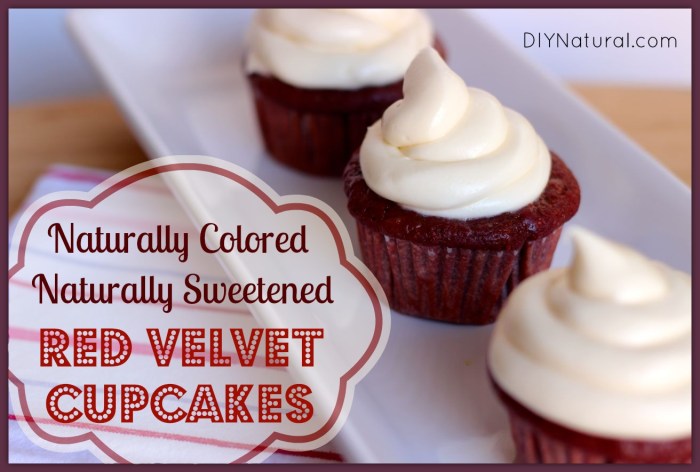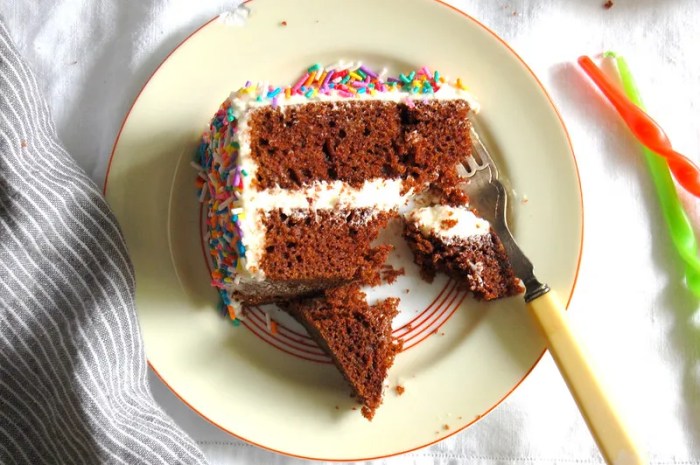Recipe Variations & Adaptations

Red velvet no food coloring – This section explores diverse approaches to crafting naturally red velvet cakes, cupcakes, and brownies, catering to various dietary needs and preferences. We’ll explore different natural red color sources and adapt classic recipes for gluten-free and vegan diets.
Naturally Red Velvet Cakes: Three Variations
Three distinct recipes showcase the versatility of natural red food coloring. Each recipe uses a different primary ingredient to achieve the characteristic red hue. Baking times and temperatures may vary slightly depending on your oven.
- Beetroot Red Velvet Cake: This recipe utilizes the vibrant color and earthy sweetness of beetroot. Combine 1 cup cooked and pureed beetroot with the wet ingredients of a standard red velvet cake recipe. Bake at 350°F (175°C) for 30-35 minutes. The beetroot adds a subtle earthy note complementing the cake’s inherent flavor profile. A visual inspection of the cake’s internal structure, specifically using a toothpick inserted into the center, is recommended to check for doneness.
- Blood Orange Red Velvet Cake: The intense color and tangy flavor of blood oranges create a unique twist. Use 1 cup of blood orange juice (freshly squeezed is best) in place of some of the liquid in a standard recipe. Bake at 350°F (175°C) for 30-35 minutes. The blood orange adds a citrusy brightness to the overall taste, offsetting the richness of the cake.
- Cranberry Red Velvet Cake: Fresh or frozen cranberries offer a tartness that beautifully contrasts the cake’s sweetness. Puree 1 cup of cranberries and incorporate them into the batter. Bake at 350°F (175°C) for 35-40 minutes. The cranberries impart a subtle tartness and a pleasing texture to the cake.
Naturally Red Velvet Cupcakes
This recipe offers a delightful alternative to traditional red velvet cupcakes, relying solely on natural ingredients for color and flavor.
- Ingredients: 1 ½ cups all-purpose flour, ½ cup unsweetened cocoa powder, 1 ½ teaspoons baking soda, ½ teaspoon baking powder, ½ teaspoon salt, 1 cup granulated sugar, ½ cup vegetable oil, 2 large eggs, 1 teaspoon vanilla extract, 1 cup buttermilk, ½ cup cooked and pureed beetroot (for color).
- Instructions: Preheat oven to 350°F (175°C). Line a muffin tin with cupcake liners. Whisk together flour, cocoa powder, baking soda, baking powder, and salt. In a separate bowl, combine sugar, oil, eggs, and vanilla. Gradually add the dry ingredients to the wet ingredients, mixing until just combined.
Achieving that signature red velvet hue without artificial food coloring can be surprisingly challenging. However, if you’re looking for inspiration for alternative color palettes or simply enjoy a bit of creative fun, you might find some helpful ideas on websites featuring cute food coloring pages. These pages can spark interesting color combinations to consider for your naturally-colored red velvet recipe, potentially leading to unique and delicious results.
Stir in the buttermilk and beetroot puree. Fill cupcake liners about ¾ full. Bake for 18-20 minutes, or until a toothpick inserted into the center comes out clean.
Naturally Red Velvet Brownies
Achieving a rich red color in brownies without artificial food coloring requires careful ingredient selection and modification of the standard recipe.
- Modifications: Incorporate a generous amount of unsweetened cocoa powder (around ¾ cup) to intensify the base color. Then add ½ cup of cooked and pureed beetroot for the vibrant red hue. The beetroot’s moisture content might require a slight adjustment to the overall liquid in the recipe.
- Baking: Bake at 325°F (160°C) for 25-30 minutes, or until a toothpick inserted into the center comes out with moist crumbs attached (brownies should be fudgy). Overbaking will result in dry brownies.
Adapting for Dietary Restrictions
These recipes can be adapted for gluten-free and vegan diets while retaining their natural red color.
- Gluten-Free: Substitute all-purpose flour with a gluten-free blend. Ensure the blend is suitable for cakes and brownies. You may need to adjust the liquid slightly as gluten-free flour can absorb more moisture.
- Vegan: Replace eggs with flax eggs (1 tablespoon flaxseed meal mixed with 3 tablespoons water per egg) or applesauce. Use vegan butter or oil instead of dairy butter. Ensure all other ingredients are vegan-friendly.
Impact on Flavor and Texture: Red Velvet No Food Coloring

Choosing natural red ingredients for red velvet significantly impacts both the flavor and texture of the final product. Unlike artificial coloring, which primarily adds color without altering taste or texture substantially, natural options introduce unique flavor notes and can affect the moisture and density of the baked goods. This thread explores these nuances.
Natural Red Ingredient Flavor Profiles
The choice of natural coloring directly influences the overall taste. Beetroot, for instance, imparts an earthy sweetness, sometimes with a slightly muddy undertone, that can complement chocolate but might require careful balancing. Alternatively, using red dragon fruit lends a subtle sweetness with hints of pear and kiwi, offering a more refreshing profile. These flavor nuances must be considered when formulating the recipe, possibly adjusting the amount of sugar or incorporating complementary spices.
Cherry juice, another option, adds a tartness that requires careful consideration in relation to the overall sweetness of the recipe.
Texture Modifications from Natural Colorants
Different natural colorants affect texture in various ways. Beetroot puree, for example, can add moisture, resulting in a more tender crumb. However, an excess can lead to a slightly denser cake. Red dragon fruit, on the other hand, tends to result in a lighter, airier texture due to its higher water content, potentially requiring minor adjustments to baking time.
The use of concentrated cherry juice, due to its higher acidity, might slightly alter the gluten development, potentially leading to a less chewy final product. Careful experimentation and recipe adjustments are key to achieving the desired texture.
Flavor Pairings for Natural Red Velvet
The unique flavor profiles introduced by natural colorants open possibilities for exciting flavor pairings. Beetroot’s earthy sweetness pairs well with spices like cinnamon and ginger, complementing the traditional chocolate flavor. Red dragon fruit’s tropical notes can be enhanced with coconut, lime, or even a hint of cardamom. The tartness from cherry juice is balanced beautifully with almond extract or a hint of orange zest.
These pairings can elevate the red velvet experience beyond the traditional.
Shelf Life and Storage
Red velvet baked goods made with natural coloring generally have a shorter shelf life compared to those made with artificial coloring. This is primarily due to the natural ingredients’ susceptibility to oxidation and spoilage. Cakes made with beetroot, for example, may show discoloration more quickly. Proper storage is crucial; airtight containers in the refrigerator extend the shelf life, but even then, they might not last as long as their artificially colored counterparts.
Freezing is a viable option for longer-term storage.
Visual Appeal and Presentation

Achieving a visually stunning red velvet treat without artificial coloring requires careful consideration of natural ingredients and presentation techniques. The subtle variations in color and texture offered by natural alternatives can be just as captivating as their artificially-colored counterparts, if approached thoughtfully.The visual characteristics of naturally-colored red velvet baked goods are significantly influenced by the chosen ingredient. Beetroot, for example, lends a deep, earthy red hue, sometimes with subtle purplish undertones depending on the variety and roasting method.
Dried cranberries, on the other hand, contribute a brighter, more crimson red, but might result in a slightly speckled appearance. Using pomegranate juice produces a vibrant, jewel-toned red, though the intensity might be less pronounced than with beetroot. The final color will also depend on the baking time and temperature.
Decorating Red Velvet Desserts with Natural Ingredients, Red velvet no food coloring
Decorating red velvet desserts naturally focuses on enhancing the existing color and adding textural contrast. Consider using fresh berries like raspberries or strawberries for pops of bright color and juicy sweetness. A dusting of cocoa powder can provide a rich, contrasting dark brown that complements the red beautifully. For a more sophisticated look, consider crystallized ginger or candied citrus peel, which offer both visual and textural interest.
Whipped coconut cream, tinted subtly with beetroot juice, offers a delicate, naturally-colored frosting alternative.
Visual Guide to Plating and Presentation Styles
Imagine a rustic wooden board showcasing individual mini red velvet cupcakes, each adorned with a single, plump raspberry. Alternatively, picture a sleek white plate featuring a slice of red velvet cake, artfully paired with a scoop of vanilla bean ice cream and a drizzle of pomegranate molasses, the deep red of the cake contrasting beautifully with the creamy white and translucent red of the molasses.
For a more modern approach, consider a square of red velvet brownie, served on a slate plate with a dusting of cocoa powder and a few fresh mint leaves, providing a visual and aromatic contrast. A towering red velvet layer cake, each layer subtly different in shade due to variations in beetroot concentration, creates a visually striking centerpiece.
Achieving a Consistent Red Color with Natural Ingredients
Achieving a consistent and visually appealing red color requires planning and precision. Start by selecting a high-quality natural coloring agent, such as beetroot powder or concentrated pomegranate juice. Ensure that the chosen ingredient is thoroughly incorporated into the batter to prevent streaking or uneven coloring. A consistent baking temperature and time are crucial for maintaining color uniformity.
For beetroot, pre-roasting enhances the color intensity. For pomegranate juice, using a reduced version intensifies the hue. Experimentation is key to finding the perfect balance between color intensity and flavor. Always test a small batch before committing to a larger recipe.
Common Queries
Can I freeze red velvet baked goods made with natural coloring?
Yes, but the shelf life might be slightly shorter compared to those made with artificial coloring. Properly wrap and freeze for optimal results.
What if my natural red coloring doesn’t create a vibrant enough red?
The intensity of color depends on the ingredient and the amount used. Experiment with increasing the quantity of your chosen natural coloring agent, or consider combining two different natural colorants for a deeper shade.
Are all natural red colorings suitable for all recipes?
No, different ingredients impart different flavors and textures. Consider the overall flavor profile of your chosen ingredient when selecting it for a particular recipe.
How do I ensure a consistent red color in my baking?
Use a consistent amount of your chosen natural coloring agent in each batch. Ensure even distribution throughout the batter by thoroughly mixing.
